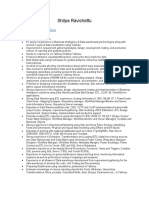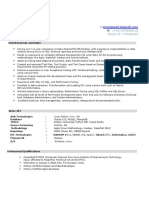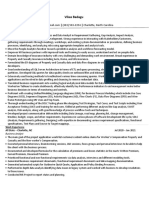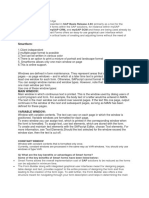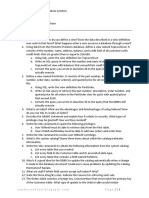Data Analyst
Uploaded by
rizqi.anwarData Analyst
Uploaded by
rizqi.anwarAll Courses
Data Science & Business Analytics Articles Ebooks Free Practice Tests On-demand Webinars
Home Resources Data Science & Business Analytics Data Analyst Job Description: Responsibilities, Skills
Required
Data Analyst Job Description: Responsibilities, Skills
Required
By Simplilearn
Last updated on Oct 18, 2023 574097 14
Table of Contents
What Is Data Analysis?
What Does a Data Analyst Do?
Data Analyst Job Description: Roles and Responsibilities
Essential Data Analyst Skills
What Tools Do Data Analysts Use?
View More
Reviewed and fact-checked by Sayantoni Das
Data has changed the face of our world over the last ten years. The numerous emails, text
messages we share, YouTube videos we watch are part of the nearly 2.5 quintillion bytes of data
generated daily across the world. Businesses, both large and small, deal with massive data
volumes, and a lot depends on their ability to glean meaningful insights from them. A data analyst
does precisely that. They interpret statistical data and turn it into useful information that businesses
and organizations can use for critical decision-making.
Organizations in all sectors are increasingly depending on data to make critical business decisions
like which products to make, which markets to enter, what investments to make, or which
customers to target. They are also using data to identify weak areas in the business that need to be
addressed.
Watch the video below that will help you have an understanding of the various responsibilities, skills
required, and the salary structure of top Data Analytics job roles.
Data Analytics Care…
As a result, data analysis has become one of the highest in-demand jobs worldwide, and data
analysts are sought after by the world’s biggest organizations. Data analyst salary and perks only
re]ect the demand of this job role which is likely to keep growing in leaps and bounds.
So if you have the skills required to become a data analyst, you would be remiss not to take
advantage of this scenario. In this article on 'data analyst job descpription' let us take a look at all
the aspects related to this job role and _nally discuss a data analyst job description in detail.
What Is Data Analysis?
The process of cleaning, analysing, interpreting, and displaying data using different approaches and
business intelligence tools is known as data analysis. Data analysis tools assist you in uncovering
key insights that lead to better informed and successful decision-making. It is concerned with the
transformation of raw data into meaningful statistics, information, and explanations.
Your Data Analytics Career is Around
The Corner!
Data Analyst Master’s Program
EXPLORE PROGRAM
What Does a Data Analyst Do?
A data analyst analyses data sets to _nd ways to solve problems relating to a business's customers.
A data analyst also communicates this information to management and other stakeholders. The
employment of these individuals encompasses many different industries such as business, _nance,
criminal justice, science, medicine, and government.
The role of a data analyst can be de_ned as someone who has the knowledge and skills to turn raw
data into information and insight, which can be used to make business decisions.
Your Data Analytics Career is Around
The Corner!
Data Analyst Master’s Program
EXPLORE PROGRAM
Data Analyst Job Description: Roles and Responsibilities
A data analyst is responsible for organizing data related to sales numbers, market research,
logistics, linguistics, or other behaviors. They utilize technical expertise to ensure data is accurate
and high-quality. Data is then analyzed, designed, and presented in a way that assists individuals,
businesses, and organizations make better decisions.
Using automated tools to extract data from primary and secondary sources
Removing corrupted data and _xing coding errors and related problems
Developing and maintaining databases, and data systems – reorganizing data in a readable
format
Performing analysis to assess the quality and meaning of data
Filter Data by reviewing reports and performance indicators to identify and correct code
problems
Using statistical tools to identify, analyze, and interpret patterns and trends in complex data sets
could be helpful for the diagnosis and prediction
Assigning numerical value to essential business functions so that business performance can be
assessed and compared over periods of time.
Analyzing local, national, and global trends that impact both the organization and the industry
Preparing reports for the management stating trends, patterns, and predictions using relevant
data
Working with programmers, engineers, and management heads to identify process improvement
opportunities, propose system modi_cations, and devise data governance strategies.
Preparing _nal analysis reports for the stakeholders to understand the data-analysis steps,
enabling them to take important decisions based on various facts and trends.
Another integral element of the data analyst job description is EDA or Exploratory Data Analysis
Project. In such data analyst projects, the analyst needs to scrutinize data to recognize and identify
patterns. The next thing data analysts do is use data modeling techniques to summarize the overall
features of data analysis.
Essential Data Analyst Skills
Data analysts need a mix of technical, analytical, and soft skills to effectively analyze data and
communicate their _ndings. Here are some essential skills for data analysts:
1. Data Cleaning and Preparation
Data analysts should know how to clean and prepare data for analysis. This includes removing
errors, identifying outliers, and transforming data into a format that can be analyzed.
2. Data Analysis and Exploration
Data analysts need to be able to analyze data and explore it for insights. This includes using
statistical methods to test hypotheses, identify trends, and make predictions.
3. Statistical Analysis
Understanding statistical tests and tools is crucial. Familiarity with mean, median, variance,
standard deviation, correlation, regression, and hypothesis testing can be fundamental.
4. Programming
Knowledge of programming languages, especially:
Python: Libraries like pandas, numpy, and scikit-learn are essential for data manipulation and
analysis.
R: Another powerful language for statistical analysis and data visualization.
5. Database Management
The ability to query databases using SQL is essential for extracting data.
Knowledge of database systems like MySQL, PostgreSQL, Oracle, or MS SQL.
6. Creating Dashboards and Reports
Data analysts need to be able to create dashboards and reports that communicate insights to
stakeholders. This includes using tools like Tableau, Power BI, and Microsoft Word to create
interactive dashboards and reports.
7. Data Visualization
Using tools and libraries like Tableau, Power BI, Matplotlib, Seaborn, or ggplot2 to represent data in
a visual format that's easy to understand.
8. Machine Learning
Machine learning is a growing _eld that is becoming increasingly important for data analysts. Data
analysts who are pro_cient in machine learning can use it to automate tasks, identify patterns, and
make predictions.
9. Excel
Often overlooked, but it's still widely used for data analysis and visualization, especially in smaller
datasets or in business settings.
10. Critical Thinking
The ability to approach problems logically and make informed decisions based on the data.
11. Attention to Detail
Ensuring accuracy in data analysis and recognizing anomalies or errors in data.
12. Communication
Clearly conveying _ndings, both written and orally, to non-technical stakeholders. This includes
creating reports and presentations that gives the insights from the data.
13. Problem-Solving
Coming up with solutions to business problems using data-driven approaches.
14. Teamwork
Collaborating with other departments or teams, understanding their needs, and providing them with
relevant data insights.
15. Ethical Judgement
Recognizing the ethical implications of data usage, storage, and analysis, especially in terms of
Find the Most Suitable
Course For You in Data
Science!
privacy and security.
What Tools Do Data Analysts Use?
SQL
SQL is widely used for data analysis in major corporations, and it is regarded as one of the most
important tools for analysts. SQL is also used in software development by software engineers. SQL
is a computer language that was designed to manage data from relational databases. It is a simple
tool to learn and may be used for complicated, digcult data analyses. It is a popular option among
data analysts since the code is simple to read and comprehend, and it can be used to edit and
update data. Furthermore, it allows you to compile data in a way similar to Excel, but over enormous
datasets and across numerous tables at once.
Microsoft Excel
Excel, a data analysis industry standard, is the most important tool to master as a data analyst. It is
a simple application to learn, and data analysts should be adept in all parts of Excel, from formula to
pivot tables. Any spreadsheet application will work, although Microsoft Excel is the most popular.
SPSS and VBA
Analysts frequently require a statistical analysis programme such as SPSS in addition to the
instruments listed above. SPSS is an excellent choice for freshly certi_ed analysts (more on SPSS
below). VBA - Visual Basic for Applications - may be required by more experienced data analysts. It
is a programming language built exclusively for Excel and is frequently used in _nancial analysis. It
is also Word and PowerPoint compatible. Matlab is another excellent tool for creating algorithms,
building models, and analysing data.
Jupyter Notebooks
Project Jupyter is a one-of-a-kind service dedicated to the development of open-source software,
open standards, and interactive computing services. It is compatible with a wide range of
programming languages. As an open-source online tool, Jupyter Notebook allows you to create and
share documents that may contain live code, equations, graphics, and narrative prose. The
notebook may be used for a variety of purposes, including data cleansing and transformation,
machine learning, and more.
The open-source programming language R, which is compatible with all platforms (Windows, Mac
OS, and Linux), is another important and widely used tool in data analytics. It is widely used by
statisticians for statistical modelling because it provides a wide range of statistical and graphical
options, and it is frequently used to undertake data wrangling. It allows the data analysts to create
data visualisations such as plots and graphs and is accessible in a variety of libraries such as Plotly.
It's employed in banking and sales, as well as several scienti_c sectors including medicine and
technology. To use this data analysis tool, you must have a basic understanding of statistics and
programming in general.
Tableau
Tableau is another application that is often used by data scientists. It is widely utilised since data
can be evaluated fast with it. Dashboards and spreadsheets are also created for visualisations.
Tableau enables the creation of dashboards that deliver actionable information and propel a
business ahead. When con_gured with the appropriate underlying operating system and hardware,
Tableau products always run in virtualized environments.
SAS
SAS (Statistical Analysis System) is a well-known commercial suite of business intelligence and
data analytics tools. The SAS Institute created it in the 1960s, and it has evolved since then. Its
primary applications now are client pro_ling, reporting, data mining, and predictive modelling.
Designed for the business market, the software is often more robust, adaptable, and user-friendly
for large enterprises. This is due to the fact that they have differing amounts of in-house
programming competence.
Microsoft Power BI
Microsoft Power BI is a relative newcomer to the market of data analytics tools, having been around
for less than a decade. It originated as an Excel plug-in before being updated as a full suite of
corporate data analysis tools in the early 2010s. Power BI helps users to quickly and easily generate
interactive visual reports and dashboards. Its key selling point is its excellent data connectivity—it
works well with Excel (as one would expect from a Microsoft product), but also with text _les, SQL
servers, and cloud sources such as Google and Facebook analytics.
Your Data Analytics Career is Around
The Corner!
Data Analyst Master’s Program
EXPLORE PROGRAM
Data Analyst Qualiacations: What Does it Take
After data analyst job description and skills, let us learn more about the quali_cations of a data
analyst. You need more than technical expertise to excel in a career in data analytics. A bachelor’s
degree in a _eld that emphasizes on statistical and analytical skills is desired. Students from
mathematics, statistics, computer science, or economics background usually have an edge in the
data analyst career path. However, a postgraduate course in data analytics like Data Analytics
Bootcamp can make you an industry-ready professional.
You would also need soft data analyst skills like:
excellent communication and presentation skills
ability for critical thinking
creativity
having a systematic and logical approach to problem-solving
team working skills
Types of Data Analysts
Medical and Health Care Analyst
As the name implies, medical and healthcare data analysts use data from a number of sources to
assist improve healthcare outcomes. They typically concentrate on the business side of medicine,
increasing patient care or simplifying operations.
Market Research Analyst
Market research analysts collect and evaluate consumer and competitor data. Market research
analysts investigate market circumstances in order to assess future sales of a product or service.
They assist businesses in determining what items customers desire, who will buy them, and at what
price.
Business Analyst
Data is used by business analysts to create business insights and advocate improvements in
corporations and other organisations. Business analysts may detect problems in almost any aspect
of a business, including IT processes, organisational structures, and employee development. As
companies are constantly striving to improve their overall egciency and save expenses, business
analytics is gradually becoming an essential component of their operations.
Business Intelligence Analyst
A business intelligence analyst (BI analyst) analyses data and other information to assist _rms in
making effective business choices. They may collect, clean, and analyse data such as a company's
revenue, sales, market intelligence, or consumer engagement indicators. BI analysts may also be
required to create tools and data models to aid in the visualisation or monitoring of data.
Operations Research Analyst
Operations research analysts are high-level issue solvers that employ sophisticated problem-solving
approaches such as optimization, data mining, statistical analysis, and mathematical modelling to
provide solutions that help _rms and organizations function more egciently and cost-effectively.
Intelligence Analyst
Analysts of intelligence examine information and data in order to identify and mitigate security
concerns. Internal and external statistics, databases, and _eld reports are examples of information
sources. To synthesise information and generate action plans, analysts must have good research,
comprehension, and analytical abilities.
Data Analyst Salary: How Much Does a Data Analyst Make?
Does the data analyst job description excite you enough? If not let us look at some salary _gures of
this in-demand job role. However, note that, the data analyst salary depends on a number of factors
like educational quali_cation, location, relevant experience, and skills set.
The average annual salary of an experienced data analyst can range from approximately $60,000 to
$140,000. Financial and technology _rms tend to offer higher pay-package than average.
Read more: How to Become a Data Analyst in 2023
The cross-market average data analyst salary is approximately $73,528
Data analysts typically move on to higher positions like senior data analysts, data scientists, data
analytics managers, business analysts, etc. Higher responsibilities come with a substantial pay rise
as well. It is estimated that the average annual salary of data scientists starts at around $95,000,
while that of analytical managers begins at approximately $106,000.
Your Data Analytics Career is Around
The Corner!
Data Analyst Master’s Program
EXPLORE PROGRAM
Top Companies Hiring Data Analysts
If you are looking for a data analyst job, you can choose from more than 86 thousand open jobs
worldwide. Shocking, isn’t it? This is mainly because nearly all industries bene_t from data analysis.
Today, the data analyst job description is branching off into various specializations like _nance,
healthcare, business, marketing, and e-commerce.
Presently, business intelligence companies have the highest number of job openings for data
analysts in the US and Europe, followed by _nance, sharing economy services, healthcare, and
entertainment companies.
Some of the top global companies hiring data analysts include Amazon, Net]ix, Google, Intuit,
Facebook, Apple, CISCO Systems. Smaller companies include Focus KPI, Agnity Solutions, Norgate
Technology, Financial giants like Paypal and Barclays are also hiring data analysts across various
departments.
Choose the Right Program
Looking to build a career in the exciting _eld of data analytics? Our Data Analytics courses are
designed to provide you with the skills and knowledge you need to excel in this rapidly growing
industry. Our expert instructors will guide you through hands-on projects, real-world scenarios, and
case studies, giving you the practical experience you need to succeed. With our courses, you'll learn
to analyze data, create insightful reports, and make data-driven decisions that can help drive
business success.
Post Graduate Program In Data
Program Name Data Analyst Analytics
Program Available In All Geos All Geos
University Simplilearn Purdue
Course Duration 11 Months 8 Months
Coding Experience Required No Basic
10+ skills including Python,
Data Analytics, Statistical
Skills You Will Learn MySQL, Tableau, NumPy and
Analysis using Excel, Data
more
Analysis Python and R, and more
Purdue Alumni Association
Applied Learning via Capstone
Membership
Additional Bene_ts and 20+ industry-relevant Data
Free IIMJobs Pro-Membership of
Analytics projects
6 months
Cost $$ $$$$
Explore Program Explore Program
Get Started to Become a Data Analyst Today!
Now that you know all about data analyst job description, skills and quali_cations, are you
wondering how to get a job as a data analyst? Let’s break down the career progression. It would be
easy for you to bag an entry-level data analysis job if you have a certi_cation from a top-rated data
analysis program like the ones we offer here at Simplilearn. Even if you don’t have a background in
data analysis, consider these to have a successful career as a data analyst. Enroll in our Data
Analyst course and start your data analytics journey today!
Earn a bachelor’s degree from a reputed University in a _eld that emphasizes on statistical and
analytical skills
Learn Data Analytics skills
Consider earning a certi_cate in Data Science or Business Analytics
Grab your _rst data analyst job
Earn a master’s degree in data analytics, and you can become a data engineer and eventually a
data scientist.
There is no shortage of jobs for skillful data analysts in whichever location you are. A data analyst
career is a rewarding journey to embark on, irrespective of the industry you choose to work in.
Want to learn more about how to get a job as a data analyst? Prepare for Data Analyst interview
questions with any of the data analysis courses offered by a top educational institution like
Simplilearn, one of the leading online certi_cation training providers in the world.
FAQs
1. What are the duties of a data analyst?
Data analysts are responsible for collecting, processing, and analyzing data to extract valuable
insights and support decision-making processes.
2. Is data analyst an IT job?
While data analysts work closely with technology and data-related tools, data analysis is not
typically classi_ed as an IT (Information Technology) job. Data analysts focus on interpreting and
analyzing data to extract insights for business decision-making. However, data analysts often
collaborate with IT professionals to access and manage data effectively.
3. Who does a Data Analyst work with?
Who a Data Analyst works with depends on the type of industry their work within. Data Analysts
work in multiple industries including _nance, business, science, government, medicine, etc.
4. Does data analyst require coding?
Yes, data analysts often require coding skills. Pro_ciency in programming languages like Python, R,
or SQL is crucial for data manipulation, statistical analysis, and data visualization. Coding allows
data analysts to clean and preprocess data, perform complex calculations, and create automated
data pipelines.
5. What does a Data Analyst do?
A Data Analyst is responsible for collecting, organizing, cleaning and identifying trends from raw
data.
6. What responsibilities are common for Data Analyst jobs?
Common responsibilities for Data Analysts include extracting data using special tools and software,
responding to data-related queries, setting up processes to make data more egcient, analyzing and
interpreting trends from the data, and reporting trends to add business value.
7. What are the typical qualiacations for Data Analyst jobs?
Typical quali_cations for Data Analyst jobs include a Bachelor’s Degree in science, mathematics, or
related _elds and a postgraduate degree in data analytics or a related _eld. It is also important to
have the knowledge of programming languages such as Python and R.
8. Is a data analyst job digcult?
The digculty level of a data analyst job can vary depending on the complexity of the data being
analyzed, the scope of the projects, and the level of expertise of the analyst. Data analysis involves
dealing with large datasets, complex problems, and the need to continually update skills to keep up
with evolving technology. However, with the right education, training, and experience, many _nd the
challenges of a data analyst job intellectually stimulating and rewarding.
9. Is data analytics a good career?
Skilled Data Analysts are in high demand in today’s data driven world. Because of the high demand,
skilled analysts can command good perks and salaries.
10. Does the role of a data analyst offer a high salary?
According to Glassdoor, a data analyst in the United States can earn a minimum salary of $43K to a
maximum of $95K per year. While a data analyst in India can earn an average salary of INR 500K per
annum.
11. Is being a data analyst a hard job?
Data Analyst is neither a hard or an easy job, but a combination of both. The hard part is
understanding languages like Python, and tools Excel and Tableau.
12. What is a data analyst?
A data analyst is a professional who gathers, interprets, and analyzes large sets of data to derive
insights and inform decision-making. They work with various types of data, such as numerical,
textual, or visual, and use statistical techniques, data visualization tools, and programming
languages to transform raw data into meaningful information.
13. What are the top data analyst responsibilities?
The top responsibilities of a data analyst typically include:
Data Collection
Data Cleaning and Preprocessing
Data Analysis
Data Visualization
Report Generation
Data Modeling
Data Quality Assurance
Collaborative Decision-Making
Continuous Learning and Improvement
Data Privacy and Security
Find our Data Analyst Online Bootcamp in top cities:
Name Date Place
Class starts on 4th Dec 2023,
Data Analyst Your City
Weekdays batch
Data Analyst Course in Jakarta, Class starts on 9th Dec 2023,
Jakarta
Indonesia Weekend batch
Class starts on 11th Dec 2023,
Data Analyst Your City
Weekdays batch
About the Author
Simplilearn
Simplilearn is one of the world’s leading providers of online training for Digital Marketing, Cloud
Computing, Project Management, Data Science, IT, Software Development, and many other emer…
View More
Recommended Programs
Data Analyst Lifetime
Access*
28727 Learners
Post Graduate Program in Data Analytics Lifetime
Access*
7734 Learners
*Lifetime access to high-quality, self-paced e-learning content.
Explore Category
NEXT ARTICLE
Business Analyst Job Description:
Salaries and Skills for 2024
By Nikita Duggal Nov 21, 2023
Recommended Resources
Data Analyst Resume What Is a Quality How to Become a Data Busi
Guide Analyst? Job Descripti… Analyst: A Step-by-Ste… Care
Ebook Article Tutorial
Follow us! Company Work with us
About us Become an instructor
Refer and Earn
Careers Blog as guest
Newsroom
Alumni speak
Grievance redressal
Contact us
Our Locations
Discover For Businesses Learn On the Go!
Skillup Corporate training
Get the Android App
Skillup Sitemap Partners
Get the iOS App
Resources Digital Transformation
RSS feed
City Sitemap
Trending Post Graduate Programs
Artificial Intelligence Course | Cloud Computing Certification Course | Full Stack Web Development
Course | PG in Data Science | MS in Artificial Intelligence | Product Management Certification Course
| Blockchain Course | Project Management Certification Course | Cyber Security Certification Course |
Lean Six Sigma Certification Course | Data Analytics Program | AI and ML Course | Business Analysis
Certification Course | Data Engineering Certification Courses | Supply Chain Management Course
Trending Master Programs
PMP Plus Certification Training Course | Data Science Certifiation Course | Data Analyst Course |
Masters in Artificial Intelligence | Cloud Architect Certification Training Course | DevOps Engineer
Certification Training Course | Digital Marketing Course | Cyber Security Expert Course | MEAN Stack
Developer Course | Business Analyst Course
Trending Courses
PMP Certification Training Course | CSM Certification Course | Data Science with Python Course |
Tableau Certification Course | Power BI Certification Course | TOGAF Certification Course | ITIL 4
Foundation Certification Training Course | CISSP Certification Training | Java Certification Course |
Python Certification Training Course | Big Data Hadoop Course | Leading SAFe ® 6 training with SAFe
Agilist Certification
Trending Categories
Project Management Courses | IT Service and Architecture | Cyber Security Courses | Digital
Marketing | DevOps | AI & Machine Learning | Big Data | Business and Leadership | Professional
Courses | Software Engineering Certifications | Management Courses | Excel Courses | Job Oriented
Courses | MBA Courses | Technical Courses | Computer Courses | Web Development Courses |
Business Courses | University Courses | NLP Courses | PG Courses | Online Certifications |
Certifications That Pay Well | Javascript Bootcamp | Software Engineering Bootcamps | Chat GPT
Courses | Generative AI Courses | Quality Management Courses | Agile Certifications | Cloud
Computing Courses
Trending Resources
Python Tutorial | JavaScript Tutorial | Java Tutorial | Angular Tutorial | Node.js Tutorial | Docker
Tutorial | Git Tutorial | Kubernetes Tutorial | Power BI Tutorial | CSS Tutorial
Terms and Conditions Privacy Policy Refund Policy
© 2009-2023 - Simplilearn Solutions. All Rights Reserved. The certi_cation names are the trademarks of their respective owners.
Disclaimer
PMP, PMI, PMBOK, CAPM, PgMP, PfMP, ACP, PBA, RMP, SP, and OPM3 are registered marks of the Project Management Institute, Inc.
You might also like
- Debi Prasad Ratha: Tableau Developer - Softwar E EngineerNo ratings yetDebi Prasad Ratha: Tableau Developer - Softwar E Engineer2 pages
- (Excerpts From) Investigating Performance: Design and Outcomes With XapiFrom Everand(Excerpts From) Investigating Performance: Design and Outcomes With XapiNo ratings yet
- Naman Goyal: (+91) - 8755885130 Skype Id - Nmngoyal1No ratings yetNaman Goyal: (+91) - 8755885130 Skype Id - Nmngoyal13 pages
- Data Analyst Interview Questions by Jessica AyodeleNo ratings yetData Analyst Interview Questions by Jessica Ayodele10 pages
- Sandeep Vallabhaneni: SQL Server Dba / Developer/ Bi DeveloperNo ratings yetSandeep Vallabhaneni: SQL Server Dba / Developer/ Bi Developer8 pages
- Ayesha Rani: Maersk Global Service Centers (India) Pvt. LTDNo ratings yetAyesha Rani: Maersk Global Service Centers (India) Pvt. LTD5 pages
- Angshuk Dutta - Data Visualization Architect ResumeNo ratings yetAngshuk Dutta - Data Visualization Architect Resume3 pages
- Sample Resume 5 - Python, SQL, Tableau, R, Excel, powerBI, Linux, Alteryx 2.5yrsNo ratings yetSample Resume 5 - Python, SQL, Tableau, R, Excel, powerBI, Linux, Alteryx 2.5yrs1 page
- Global ERP Solutions Inc.: DWH - Bi - Informatica - Pl/Sql-AnalystNo ratings yetGlobal ERP Solutions Inc.: DWH - Bi - Informatica - Pl/Sql-Analyst7 pages
- Top Business Analyst Interview QuestionsNo ratings yetTop Business Analyst Interview Questions7 pages
- Sales Amount by Month - Sort It by The Correct Month Order, Not Alphabetical OrderNo ratings yetSales Amount by Month - Sort It by The Correct Month Order, Not Alphabetical Order6 pages
- Suganya Rangasamy Resume Talend-AWS-InformaticaNo ratings yetSuganya Rangasamy Resume Talend-AWS-Informatica2 pages
- Msbi Developer: B.Sreedhara Reddy Email Id: Bsreedharreddy86 Mobile: +91-9590911350100% (1)Msbi Developer: B.Sreedhara Reddy Email Id: Bsreedharreddy86 Mobile: +91-95909113504 pages
- XXXXX Mob No: +91-: Cytogenomics India Pvt. LTDNo ratings yetXXXXX Mob No: +91-: Cytogenomics India Pvt. LTD4 pages
- Worked Extensively in Several Projects in Both OLAP and OLTP ApplicationsNo ratings yetWorked Extensively in Several Projects in Both OLAP and OLTP Applications3 pages
- Nidhi Professional Summary:: Analysis ServicesNo ratings yetNidhi Professional Summary:: Analysis Services5 pages
- The Power of Prediction in Health Care: A Step-by-step Guide to Data Science in Health CareFrom EverandThe Power of Prediction in Health Care: A Step-by-step Guide to Data Science in Health CareNo ratings yet
- The Definitive Guide to Data Integration: Unlock the power of data integration to efficiently manage, transform, and analyze dataFrom EverandThe Definitive Guide to Data Integration: Unlock the power of data integration to efficiently manage, transform, and analyze dataNo ratings yet
- Java Lang IMP Questions by VJTech AcademyNo ratings yetJava Lang IMP Questions by VJTech Academy84 pages
- Applied Multivariate Statistics in R 1684815170No ratings yetApplied Multivariate Statistics in R 1684815170528 pages
- Unit - Iii: Malla Reddy Engineering College For WomenNo ratings yetUnit - Iii: Malla Reddy Engineering College For Women35 pages
- Data Structures and Algorithms Lab Journal - Lab 5No ratings yetData Structures and Algorithms Lab Journal - Lab 511 pages
- HND Computing UNIT 38: Database Management SystemsNo ratings yetHND Computing UNIT 38: Database Management Systems21 pages
- Group 9 Project Proposal Business PermitNo ratings yetGroup 9 Project Proposal Business Permit12 pages
- Using The Amicus18 Compiler With MPLAB IDENo ratings yetUsing The Amicus18 Compiler With MPLAB IDE13 pages
- Gokaraju Rangaraju Institute of Engineering and TechnologyNo ratings yetGokaraju Rangaraju Institute of Engineering and Technology17 pages
- Choosing OCR AS/A Level Computer Science (H046/H446)No ratings yetChoosing OCR AS/A Level Computer Science (H046/H446)60 pages
- Learning SQL 2nd edition Edition Alan Beaulieu - The full ebook version is ready for instant download100% (3)Learning SQL 2nd edition Edition Alan Beaulieu - The full ebook version is ready for instant download47 pages
- (Ebook) C++ templates: the complete guide by David Vandevoorde & Nicolai M. Josuttis & Douglas Gregor ISBN 9780321714121, 0321714121 2024 scribd download100% (7)(Ebook) C++ templates: the complete guide by David Vandevoorde & Nicolai M. Josuttis & Douglas Gregor ISBN 9780321714121, 0321714121 2024 scribd download65 pages







